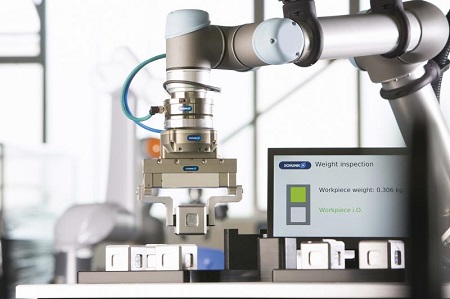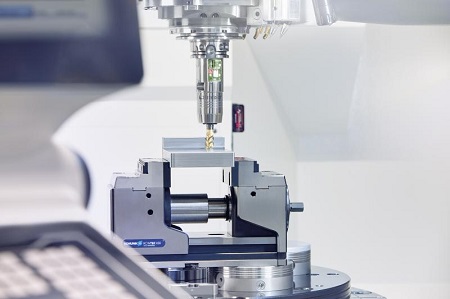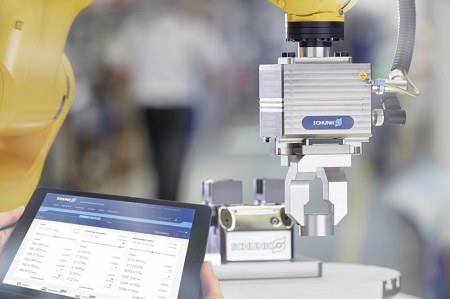
Demanding gripping processes can be achieved with the SCHUNK EGL due to the PROFINET interface and edge technologies.
They give an early warning of incipient damage, detect deviations in quality, monitor the stability of a production process and ensure consistent quality control at all stages of production and value creation. In this context, gripping systems and clamping devices are growing rapidly in importance due to their closest-to-the-part position.
User demand for higher productivity, automated system availability and process reliability impacts the machines and automated systems used in modern production. The ability to carry out continuous condition monitoring is increasingly becoming a key criterion in component selection. The ability to analyze production and quality data clocked with production offers the potential for significant cost savings, higher operational efficiency and improved production quality. Most importantly, the higher availability of automated systems and just-in-time maintenance have been shown to improve operational efficiency. Ideally, unplanned downtimes for automated systems can be eliminated completely. In turn, product quality can be increased by incorporating data on machine wear into the process controls and by predicting deviations from standard quality so that any necessary actions can be taken in a timely manner.
Not only reading data, but analyzing data
There is already an enormous amount of data being generated by the machines and automated systems, smart tools and components found in the factories of manufacturing companies. However, only a very small fraction of this data is actually being used - estimates suggest only about five percent. Values recorded by sensors have been given very little significance thus far, at most being used in the event of damage or for troubleshooting. By using this existing data comprehensively, systematically and most importantly in real time, smart manufacturing scenarios can be achieved that promise substantial benefits. At the same time, the degree of networking and digitalization is also associated with a rapid increase in the amount of data being generated, meaning that there may be a risk that the connections to the cloud data centers may not be able to cope with the immense and rapidly growing data streams, and that downtimes and high latency periods could occur. That is why current research projects are focusing on a fundamental shift in how data is understood. It no longer revolves around simply collecting data as was the case previously, but around analyzing the data on site and converting it into valuable information. The primary focus is on how to refine big data into smart data. For example, information on whether an automated system is operating properly and whether it is ideally linked to appropriate recommended actions needs to be prepared.
Integrated component testing
This allows component quality characteristics to be checked during handling and OK/NOK decisions to be made directly in the gripper. The data recorded in the gripper is pre-processed and analyzed in the components in real time so that the appropriate responses are triggered. This reduces the data volume to be transferred to what is truly required, i.e. a somewhat bewildering abundance of data is conveyed as meaningful parameters or key performance indicators (KPIs). In addition to standard downtime statistics, the most important KPIs are the process capability indices (Cp) from the statistical process analysis and the utilization efficiency of the overall automated system. This measures three types of performance data and uses multiplicative methods to merge them into a comprehensive productivity indicator, the total efficiency of the automated system or the overall equipment effectiveness (OEE).
Total automated system efficiency as a key indicator
Three factors are relevant when determining the OEE:
Degree of performance (LG): The degree of performance is a measure of a production system's processing speed. This is based on the cycle/cycle times for the output interval for good parts or the productive capacity (M). The degree of performance is indicated in the form of cycle times and quantities.
Cycle times: LG = tplan/treal x 100 %
Quantities: LG = Mreal/Mplan x 100 %
Degree of utilization (NG, availability): The degree of utilization is a measure of a production system's ability to successfully perform a required function at the required time. This is determined based on operating times, the downtime rate λ, the mean time between failure (MTBF), and the mean down time (MDT). The latter includes several factors such as the maintenance time TW and the repair time (mean time to repair, MTTR).
NG=(∑ Operating times)/(∑Operating times+∑Downtimes) = MTBF/MTBF+MDT
The reliability indicates the likelihood of not having downtime that will affect the functionality of a unit during a certain period. This is determined by the downtime rate for the technical elements and quantified by the mean period without downtimes (operating time), the "Mean Time Between Failures" (MTBF).
MTBF=1/λ with downtime rate λ
Quality performance (yield, ...): Quality performance is a measure of a production system's ability to assemble/test within prescribed specifications. Methods of statistical quality assessment are used to analyze and evaluate the quality behavior of manufacturing processes. Sampling information is used to try to obtain information concerning distribution time behavior, for example in the assembly process. The results of this analysis are the calculations of the "short-term machine capability" (machine potential Cm, Cmk), the "preliminary process capability" (preliminary process potential Pp, Ppk) and the "long-term process capability" (long-term process potential Cp, Cpk).
Machine capability is a measure of the short-term characteristic variance coming from the machine.
Process capability is a meaningful measure of the stability of a process. It indicates whether a process is able to meet the requirements that have been set. In such cases, this is referred to as manageable production processes. At the same time, it also provides insight into the long-term behavior of the overall system under the prevailing general conditions (humans, machines, methods, work environments). Process capability identifies the ability of a machine or process to achieve specified characteristics with a frequency distribution that is within the required tolerances. For this purpose, the relationship between the statistical distribution of a measurable quality characteristic and the tolerance range specified for this characteristic is created. Process capability parameters are very sensitive to changes and trend developments. This means that they are particularly suitable for medium-term forecasts and predictive maintenance.
The gripper as a universal enabler for smart, flexible production
Smart handling modules easily create the preconditions necessary for the full integration of automated production systems in manufacturing environments and open up the possibility of connections to cloud-based ecosystems in order to determine the overall effectiveness of the automated system (OEE), the downtime statistics (MTBF, MTTR) and the medium-term process stability using the capability parameters determined. One of these kinds of key components is the SCHUNK EGL parallel gripper, a smart standard gripping module that includes standard integrated functions, a certified Profinet interface and integrated electronics with variable stroke and a gripping force that can be set between 50 N and 600 N. As an inline measuring system, when "smart gripping" the intelligent gripper uses its exposed position directly at the workpiece to obtain data and evaluate it immediately using the edge technology integrated into the gripper. Each individual process step can be monitored in detail and for example relayed to the system control system, the higher-level ERP system but also to analysis databases and cloud solutions. In this way, the smart gripper is able to capture and process systematic information about the gripped part, the process and components and also performs appropriate reactions themselves. This enables closed-loop quality inspection and direct monitoring of the production process in the production cycle.
Proactive trend detection
Most importantly, the continuous real-time determination of the long-term process capability (Cpk) for proactive trend detection and error diagnosis has a proven track record with the gripper. The control corrections introduced have already taken effect before reaching the specification limits and allow for a significantly more stable process control. Sensors are merged so that several sensors can be used in parallel and their measured values subsequently analyzed in order to monitor and evaluate current system states of the gripper and the gripping access situation. This makes it possible to differentiate between gripping objects and to detect malfunctions in the production sequence such as differing raw material qualities, wearing tools, tolerance deviations or material bottlenecks. Using the real-time process analysis, trends can be evaluated and included immediately in production flow quality control, for example based on competence characteristic values. Correlation analyses also allow complex contexts to be detected and complex error patterns to be eliminated more quickly.
Artificial Intelligence
In the future, SCHUNK plans to automate tasks for controlling the entire kinematic chain, which consists of robots and grippers, as well as the monitoring of their function, without having to be programmed for each individual step or having to set thresholds and continually adjust them. The use of artificial intelligence (AI) methods and the use of different sensors will be crucial for this kind of autonomous gripping. In a pilot application for instance, methods of cognitive intelligence were used to identify randomly arranged parts using a camera and then to autonomously grip them from a transport crate and guide them into their machining process. At the same time, deviations from normal events (so-called anomalies) and trends, such as the drifting of relevant process parameters, are learned and used to refine the diagnostic instruments in the gripper, without the need for operational interruptions or excessive training when setting up the system. The purpose of the gripper is not only to grip, but also to take over the total gripper planning, to monitor the entire process using sensors and to analyze it continuously. Here, edge and cloud computing enjoy a complementary and beneficial relationship.
Sensory toolholder
Equipped with a sensor, a battery and a transmitter unit, the SCHUNK iTENDO sensory toolholder monitors the process at 5,000 Hz directly at the tool. An algorithm continuously determines a parameter for process stability. The so-called IFT value was specially developed for the iTENDO, and expresses the measured vibration as a numeric value on a defined intensity scale – similar to the Richter scale for earthquakes. If the cut becomes unstable, the integrated intelligence intervenes directly in real time with a latency of approx. 20 ms and without operator intervention. Depending on the situation, the process is then stopped, reduced or adapted to previously defined basic parameters, the infeed of tools changed, sister tools replaced or messages sent to the operator. Depending on the particular application, a web service can be used to define both the exact limits and corresponding reactions if they are exceeded. In the medium term, statistical evaluations such as Overall Equipment Effectiveness (OEE), process capability (Cpk), Mean Time Between Failure (MTBF), or trend developments like the parameter drift or gradients for failure rates should also be possible.

With Smart Gripping, smart SCHUNK grippers measure, identify, and monitor gripped components as well as the ongoing production process.

Via the built-in sensor system, the smart toolholder SCHUNK iTENDO records accelerations and vibrations directly at the workpiece and transfers the data to the control system of the machine tool.
Shop Women's Sneakers by Brand













